Online chinese wedding ceremony interaction reimagined
With Love (UIUX & Concept Design)
Mar 21 - Apr 21 (6 weeks)
Background
COVID-19 pandemic had made wedding ceremony obsolete around the world. While e-wedding had become many couples' alternative, it is clear that there the experience is not ideal. With Love is a design solution that aims to reduce the emotional gap between hosts and guest in an e-wedding.
Tools and Methods
- Affinity Diagram
- Empathy Map
- Customer Journey Map
- Personas
- Scenario sketches
Contribution
- User Research
- UI Design
- Prototyping
- Branding
- Scenario Sketches

Design Challenge Statement
"COVID-19 has separated some family members from their hometown, how might we recreated some of the activities that will typically be done between family members?"
The project began with identifying cultural community, ritual and the value behind the ritual. The team has selected Singaporean and Malaysia Chinese as the community of focus, Chinese Wedding as the ritual and "Togetherness" as the cultural value.
Problem Statement
With the social distancing measures that were put in place tackle the COVID-19 pandemic, physical wedding ceremonies had became inconvenient and dangerous to host. While this unforeseen circumstance had people turn to hosting wedding online, it is obvious that e-weddings are different from physical weddings in many ways due to the physical distance of the couple and their guests, which could prevent both parties from having the same positive experience of a physical one. Hence, this could potentially erode the core feeling of togetherness that is so highly valued in the Singaporean and Malaysian Chinese community.
Contextual Research
User Interviews
To get a better understanding of the current wedding scene in the Singaporean and Malaysian Chinese community, we interviewed a variety of target groups to get different perspectives. These included both the wedding couple and the guests from online and physical weddings. Overall, we interviewed four people, one from each target group.

Affinity Map
As a lot of qualitative data was gathered from the interviews, we used an affinity map to find natural patterns in the feedback of these four target groups we interviewed. This enabled us to get meaningful insights from the large amounts of feedback we gathered.

Empathy Map
We also wanted to articulate our findings about the different target groups that we interviewed. Hence, we created an empathy map to aid us in achieving this.


Key findings from user studies
Pain points for wedding host:
- Difficult to engage individually with guest through livestreaming
- Unable to feel presence of guests during e-wedding
Pain points for wedding guest
- Camera-shy, afraid to speak up in Zoom
- e-Angpao is less sincere because it cannot be customized
Pain point for both
Sense of detachment because there interaction is not possible.
Persona
To personify the key findings, we created two personas who represent our wedding couple and guest.
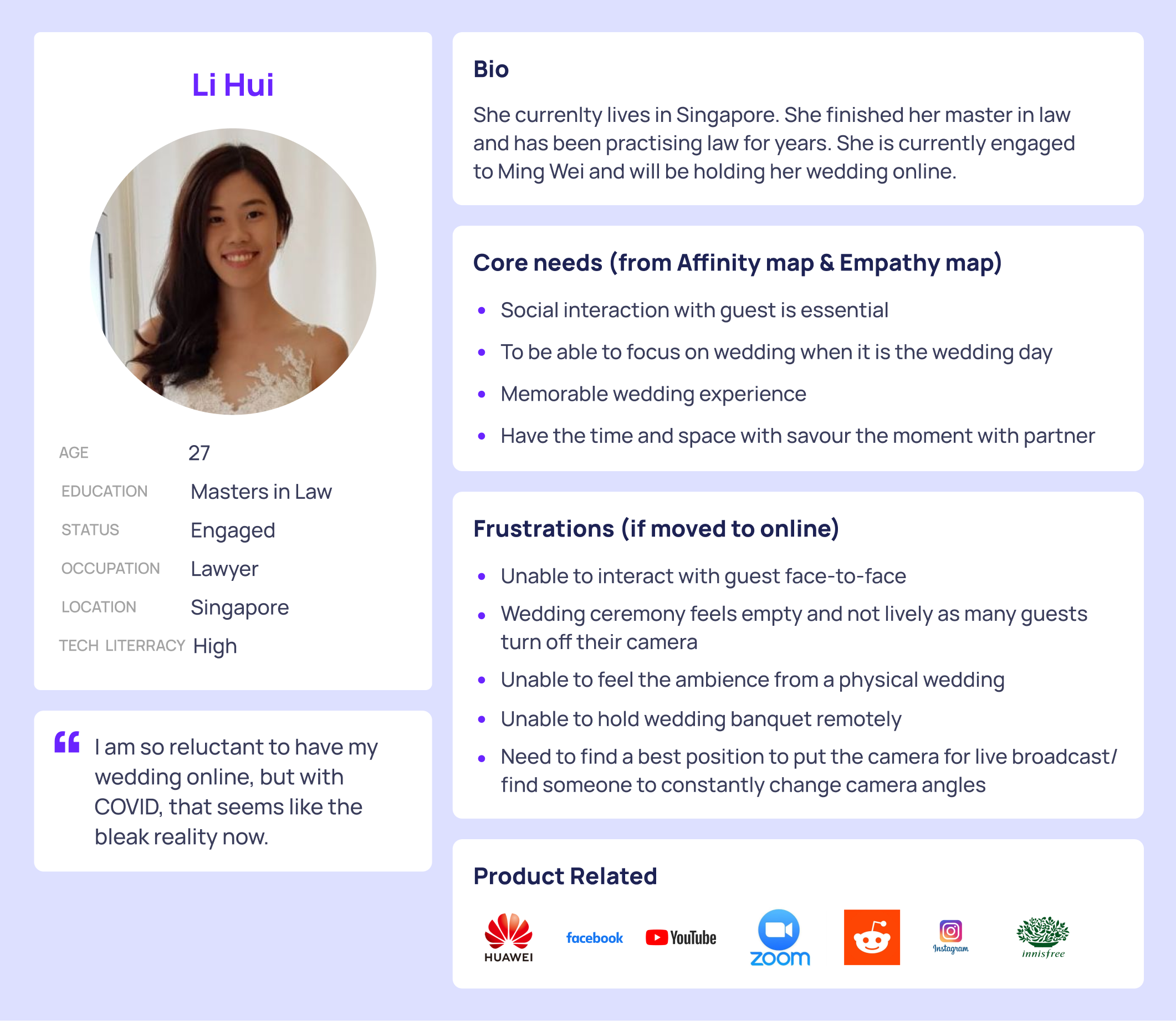

Customer Journey Map
We then used Customer Journey Map to visualize the flow of a typical e-wedding experience for the two target groups. The e-wedding process was split into three parts: pre-wedding, wedding and post-wedding. We were then able to identify gaps in the e-wedding process that we could use as design opportunities for our solution. These gaps were focused on moments where the guests and the couple where the feeling of togetherness was lacking.


Design Opportunities
From the customer journey map, we had identified a few design opportunities. To narrow down the focus, we used the potential of nurturing togetherness as the deciding factor to choose opportunity. The selected were:
- Encouragement for guests to turn on their cameras
- Customizable e-Angpao
- Well-wishes repository that removes manual hassle from hosts
Ideation
Scenario Sketches
The ideation process that we had used are scenario sketches. Through this method, we could list down the requirements of the solutions that will guide us in the prototyping phase.
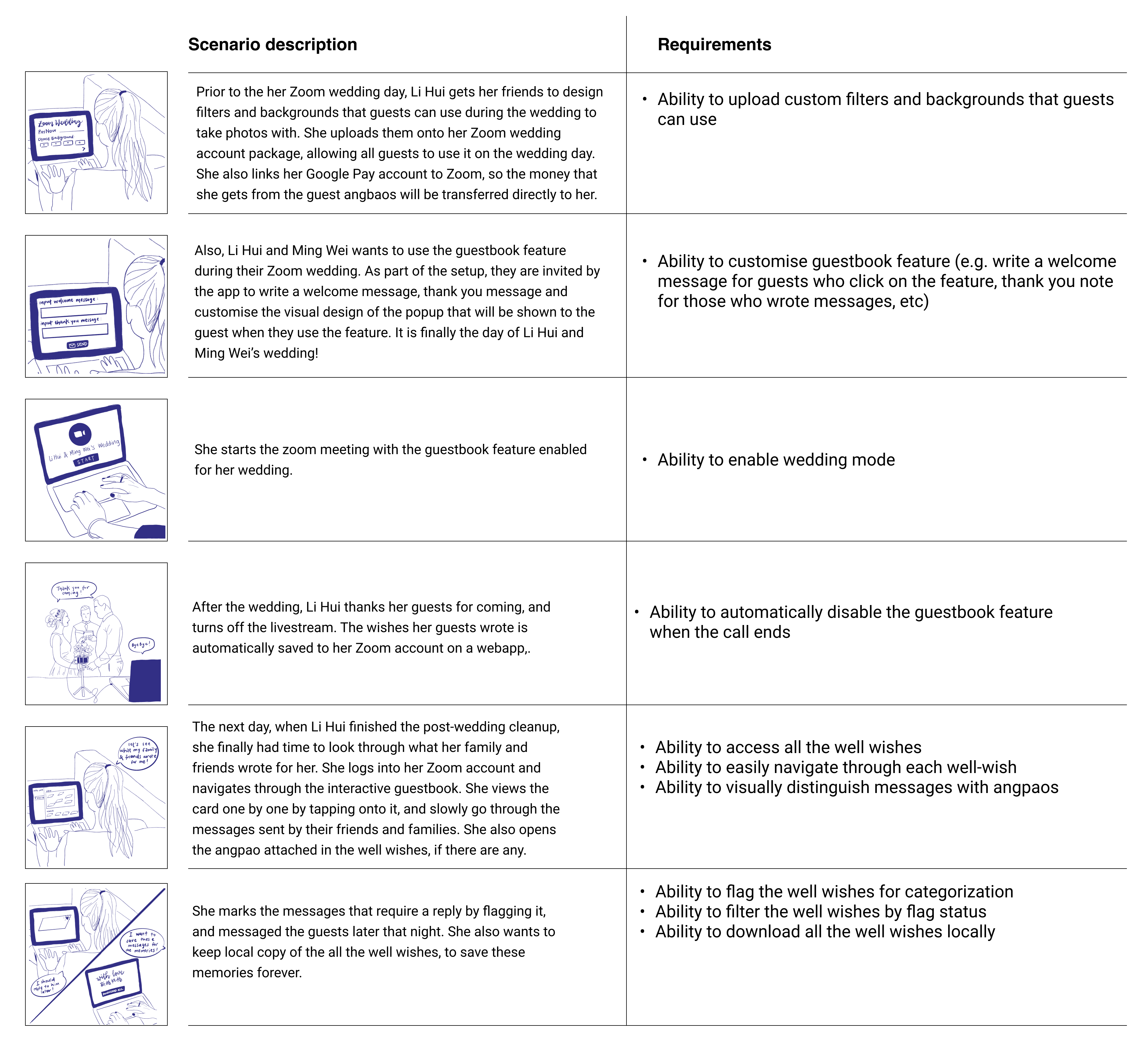
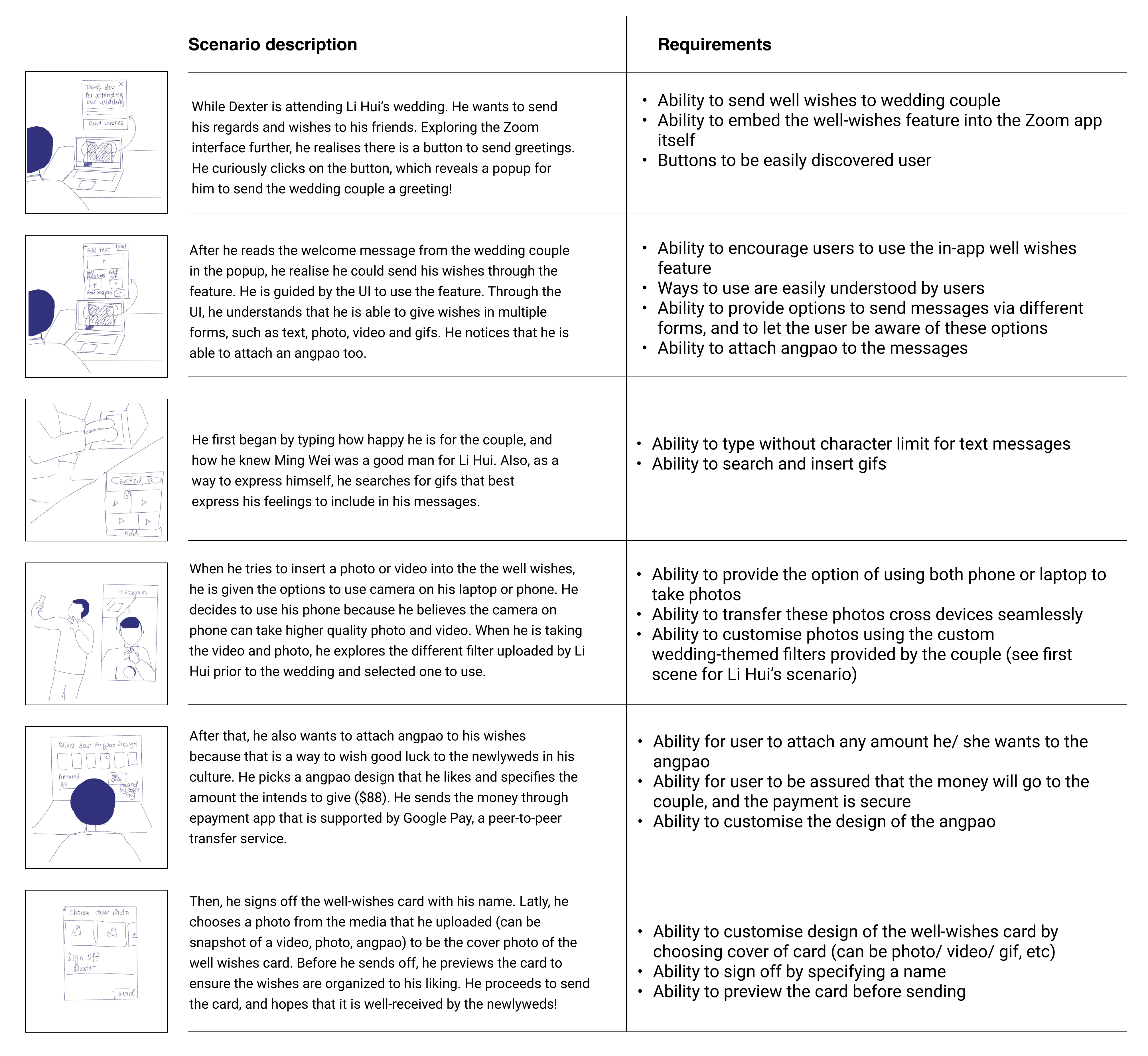
Design Solution: With Love (新婚祝福)

With Love is envisioned to be an extension that is built into Zoom. With Love aims to open up an official avenue of communication online that guests can use to give blessings to the couple. This way, the guests can stay involved in the beautiful moment, no matter what kind of guest they are. With Love aims to do this in a way that makes it known to both parties that they are enjoying the moment together.
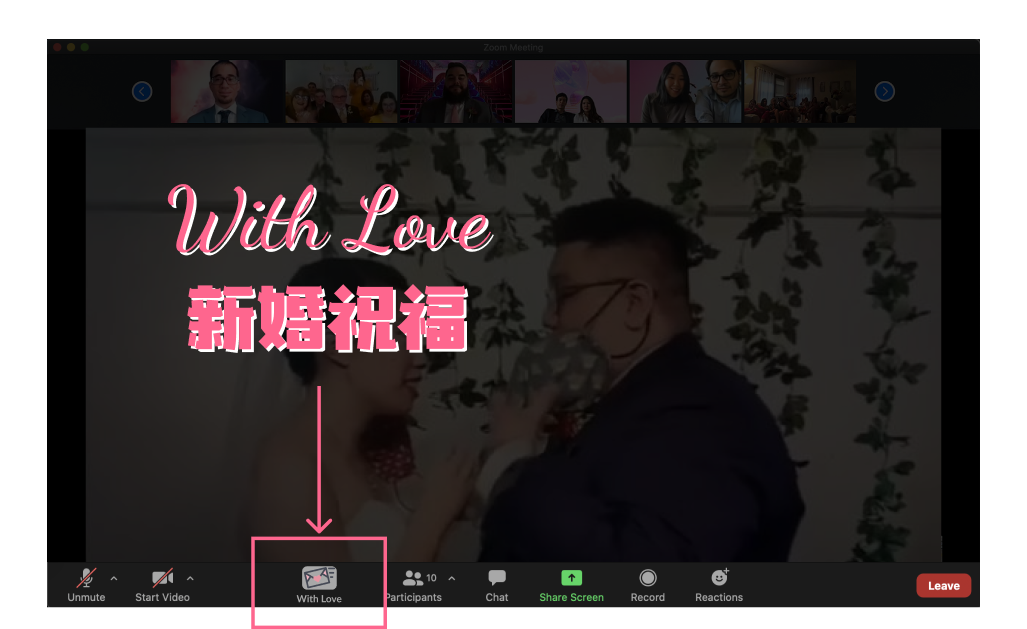
There are five features that make up With Love.
Feature 1 : Hosts Welcome Message

Feature 2 : Adding personalized virtual background to be used by guest
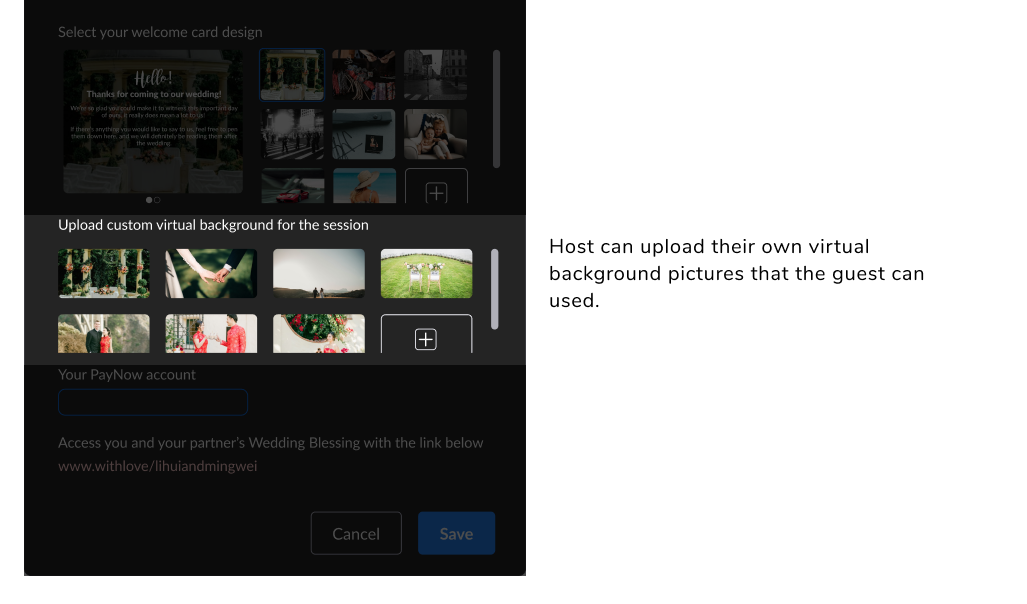
Feature 3 : Guest's Multimedia Blessings

Feature 4 : e-Angpao

Feature 5 : e-Guestbook
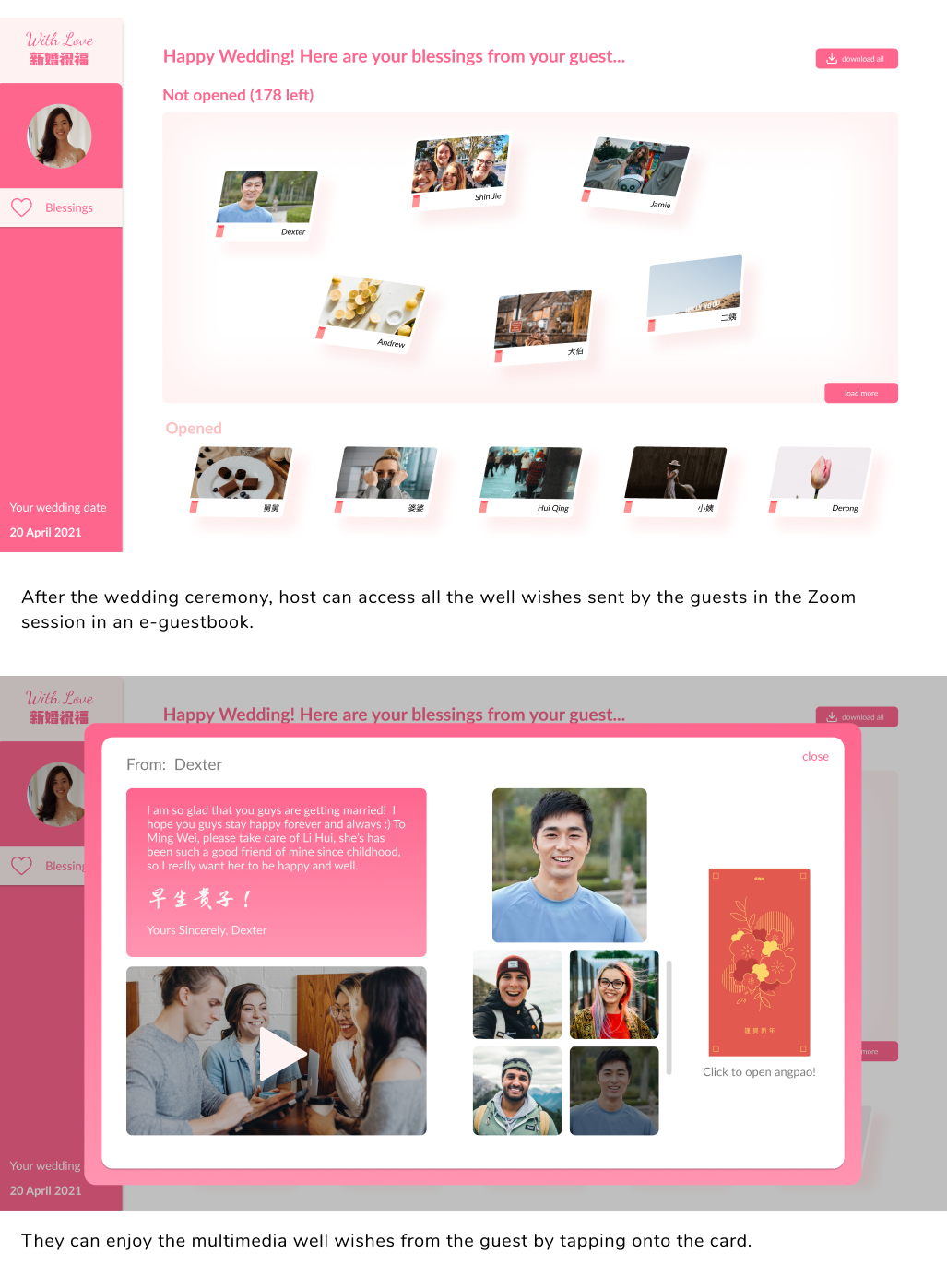
Overall Flow for Host
To prepare for the e-wedding, they would first schedule a meeting and turn on the With Love feature. They can then customize a welcome and thank you message for the guests. Additionally, they can also upload virtual backgrounds for the guests to use during the wedding itself. During the wedding, they would use Zoom as per normal. After the wedding, they would then be able to access a link provided to them after the wedding that allows them to access a web page that has collated all the guests' well wishes.

Overall Flow for Guest
All the interactions that the guest has with With Love are all during the wedding itself. The guest would first be able to access With Love as a normal button on the Zoom user interface. They would be then greeted by the couple's welcome message, and then be prompted to curate their well-wishes, with the freedom to add in photos, videos and gifs. Guests can use the virtual backgrounds from the couple in the photos and videos they attach. Once they are done, they would then be led to the 'add angpao' section, where they are able to attach an angpao with a design of their choice. They may also skip this step if they choose not to give an angpao. Upon completing both the well-wishes and angpao section, they are able to preview how the message would look like to the couple to make any changes if they want. After sending the message, they are then led to the confirmation page, where the couple's customized 'thank you' message would be displayed.

Intended Impact
Overall, With Love hopes to provide an avenue for the guest to deliver individual sincere well-wishes to the couple, and for the couple to feel the warmth of the guests' presence as they read these well-wishes. This is so that we can once again re-establish the closeness between the host and the guest, to achieve the feeling of togetherness again in an e-wedding.
Lesson Learnt
My main key takeaway from this project is that it is worth to pay a lot of attention on the research because only research would make us a better designer by solving the right problem. Besides, approaching design culturally is interesting because we were used to given clearly defined requirements, especially when doing programming. Another plus point for me was this project has made understand my own culture better.
